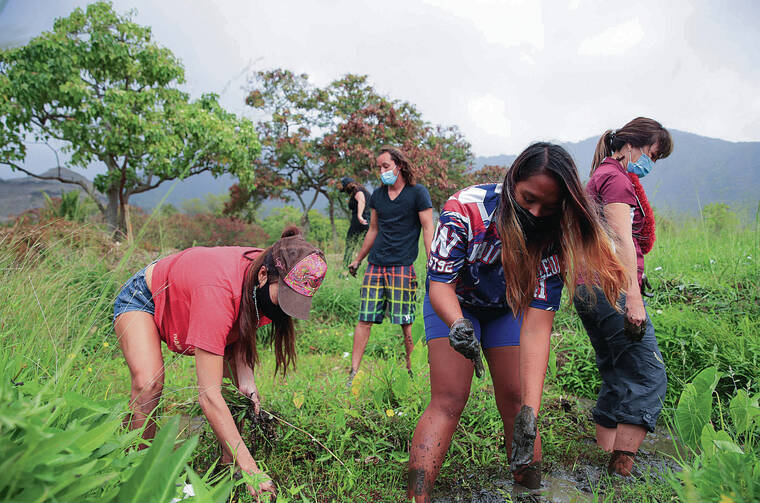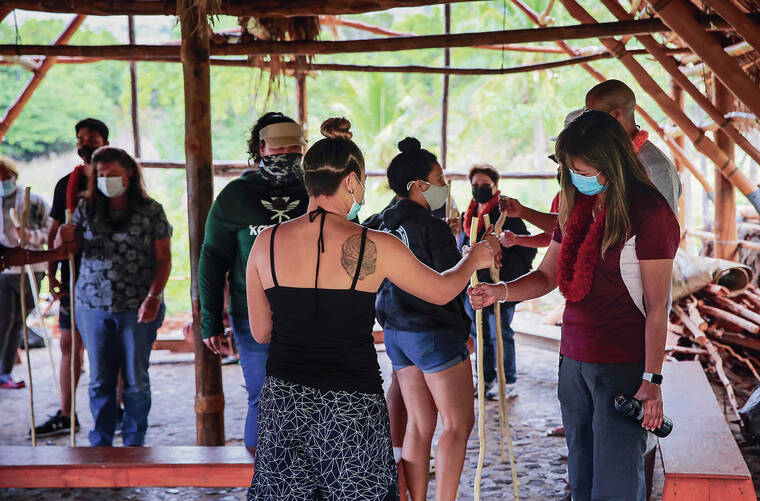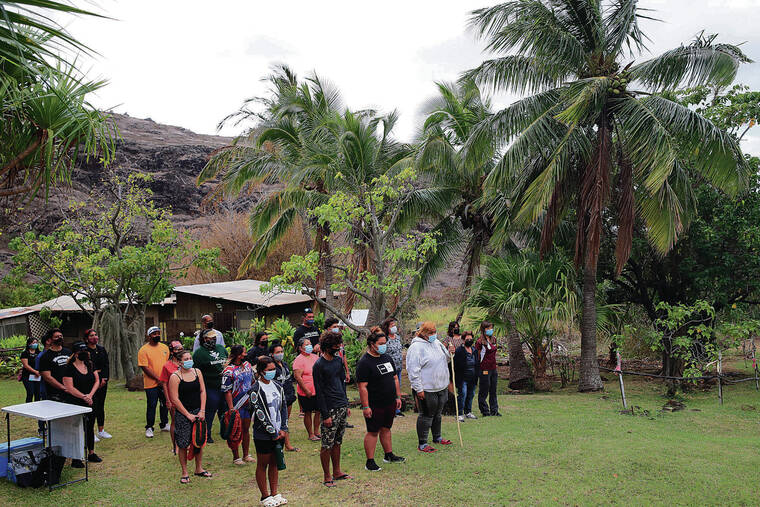For Kuali Moses-Marcellino, school was never fun until he enrolled in the Papahana ‘o Kaiona alternative learning program in Waianae. The 17-year-old used to miss a lot of class and had a difficult time paying attention. Now he spends most of his school hours in the community working in a loi, learning about Hawaiian moolelo (history) and participating in other hands-on activities. He is set to graduate with his high school diploma in May and hopes to travel the world to learn about different cultures.
“Instead of learning stuff through books and computers, we’re learning out here,” said Moses-Marcellino, who has been enrolled in the program for two years. “You learn new things every day. This is where I chose to be.”
Moses-Marcellino in May will be part of the first graduating class from Papahana ‘o Kaiona, one of the state Department of Education’s newest alternative learning programs. In Hawaii there are nearly 50 of these alternative learning programs, which offer students, many of whom come from economically disadvantaged neighborhoods and have suffered childhood trauma, opportunities to earn credits and high school diplomas in nontraditional classroom settings. Nearly 50% of students enrolled in the DOE’s alternative learning programs last school year were Native Hawaiian, said Kristy Nishimura, who heads the DOE’s alternative learning programs.
While several state officials say these programs are a good way to increase graduation rates and decrease youth incarceration, they also say there’s a need for more in the islands.
“This is the future,” said Rep. Cedric Gates, who represents the Waianae Coast and is a 2010 graduate of the alternative education program YouthBuild Honolulu. Gates was part of a group of state officials, including Sens. Maile Shimabukuro, Michelle Kidani and Donovan Dela Cruz; Reps. Stacelynn Eli and Justin Woodson; and Office of Hawaiian Affairs Board of Trustees Chairwoman Carmen Hulu Lindsey, who visited Papahana ‘o Kaiona’s students and teachers at the Ka‘ala Cultural Learning Center in Waianae on Monday. “We have to recognize that not every student will fit in that traditional setting.”
Started in 2018, Papahana ‘o Kaiona seeks to provide its 30 students, who live on the Waianae Coast, with place-based and community-
centric learning, said program administrator Ami Akeo. Students rotate among different community sites, including Kahumana Organic Farms and the Ka‘ala Cultural Learning Center, throughout the week and spend a few days in the classroom learning how to connect and apply what they learned to curriculum. They can either stay in the program or transition back to the traditional high school setting if they’re ready, she said.
Most of them are one to two grade levels behind and have experienced childhood trauma, Akeo said. Others are experiencing homelessness, and more than half have parents who have been or are currently incarcerated.
Akeo, a former Nanakuli High and Intermediate School vice principal, said traditional school settings weren’t a good fit for these students, so programs like Papahana ‘o Kaiona seek to find other ways to motivate and support them. Students still need to take the same standardized assessments as their peers, but the information is taught to them in different ways, she said. She also pointed out that because the majority of their students are Native Hawaiian and Pacific Islander, incorporating cultural components helps them to resonate with what they are learning.
“By doing, building and creating, they’re more likely to learn,” Akeo said. “These kids have so much knowledge and talent. Providing them with different opportunities to learn and shine is important.”
Kristine Ginoza, one of the program’s three kumu, said students learn about English through moolelo and stories. They learn about Hawaiian history through the places they visit, and they apply their work on the land to math skills.
“It’s trying to make the academic classroom content relevant. That’s the unique thing about our program,” said Ginoza, who has taught for nearly 25 years on the Waianae Coast. “Just in a short time, we’ve seen a lot of personal growth. Hopefully, we can grow to provide this type of learning environment to more students. There is a need.”
The hope is to open more of these alternative learning programs statewide, with the goal to have at least one in every complex area, said Dela Cruz, chairman of the Senate Ways and Means Committee. He said the state Legislature funded six new alternative learning programs in 2020.
But one of the challenges is finding facilities to house these programs. Akeo said they are using temporary classroom space in Nanakuli but are trying to find a permanent home base where they can hold some of their classes.
Gates added that alternative learning programs tied to workforce development help to prepare youth for life after high school. He said his counselor at Waianae High School recommended that he enroll in YouthBuild because he had missed a lot of school. There, he said, he learned the importance of leadership and giving back to the community, along with practical skills such as balancing your checkbook and carpentry work.
“The traditional setting was a bit challenging. There was a lot of temptation to cut class and do things we shouldn’t be doing,” he said. “I didn’t want to go down that path. I wanted to change my trajectory.”
———
Jayna Omaye covers ethnic and cultural affairs and is a corps member of Report for America, a national service organization that places journalists in local newsrooms to report on undercovered issues and communities.






